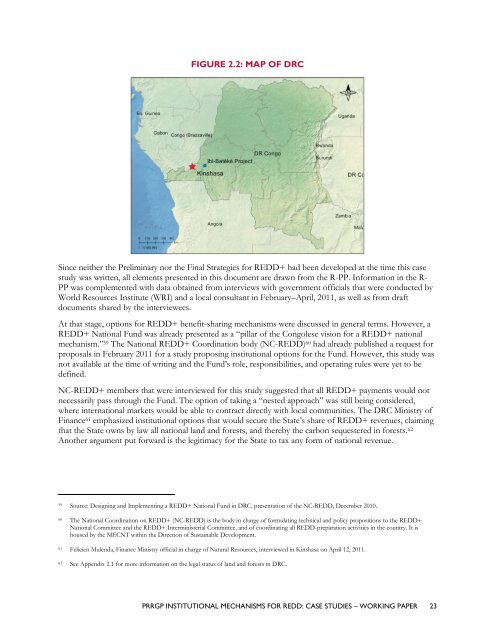Institutional Mechanisms for REDD+ - Case Studies Working Paper
Institutional Mechanisms for REDD+ - Case Studies Working Paper
Institutional Mechanisms for REDD+ - Case Studies Working Paper
Create successful ePaper yourself
Turn your PDF publications into a flip-book with our unique Google optimized e-Paper software.
FIGURE 2.2: MAP OF DRC<br />
Since neither the Preliminary nor the Final Strategies <strong>for</strong> <strong>REDD+</strong> had been developed at the time this case<br />
study was written, all elements presented in this document are drawn from the R-PP. In<strong>for</strong>mation in the R-<br />
PP was complemented with data obtained from interviews with government officials that were conducted by<br />
World Resources Institute (WRI) and a local consultant in February–April, 2011, as well as from draft<br />
documents shared by the interviewees.<br />
At that stage, options <strong>for</strong> <strong>REDD+</strong> benefit-sharing mechanisms were discussed in general terms. However, a<br />
<strong>REDD+</strong> National Fund was already presented as a ―pillar of the Congolese vision <strong>for</strong> a <strong>REDD+</strong> national<br />
mechanism.‖ 59 The National <strong>REDD+</strong> Coordination body (NC-REDD) 60 had already published a request <strong>for</strong><br />
proposals in February 2011 <strong>for</strong> a study proposing institutional options <strong>for</strong> the Fund. However, this study was<br />
not available at the time of writing and the Fund‘s role, responsibilities, and operating rules were yet to be<br />
defined.<br />
NC-<strong>REDD+</strong> members that were interviewed <strong>for</strong> this study suggested that all <strong>REDD+</strong> payments would not<br />
necessarily pass through the Fund. The option of taking a ―nested approach‖ was still being considered,<br />
where international markets would be able to contract directly with local communities. The DRC Ministry of<br />
Finance 61 emphasized institutional options that would secure the State‘s share of <strong>REDD+</strong> revenues, claiming<br />
that the State owns by law all national land and <strong>for</strong>ests, and thereby the carbon sequestered in <strong>for</strong>ests. 62<br />
Another argument put <strong>for</strong>ward is the legitimacy <strong>for</strong> the State to tax any <strong>for</strong>m of national revenue.<br />
59 Source: Designing and Implementing a <strong>REDD+</strong> National Fund in DRC, presentation of the NC-REDD, December 2010.<br />
60 The National Coordination on <strong>REDD+</strong> (NC-REDD) is the body in charge of <strong>for</strong>mulating technical and policy propositions to the <strong>REDD+</strong><br />
National Committee and the <strong>REDD+</strong> Interministerial Committee, and of coordinating all REDD-preparation activities in the country. It is<br />
housed by the MECNT within the Direction of Sustainable Development.<br />
61 Felicien Mulenda, Finance Ministry official in charge of Natural Resources, interviewed in Kinshasa on April 12, 2011.<br />
62 See Appendix 2.1 <strong>for</strong> more in<strong>for</strong>mation on the legal status of land and <strong>for</strong>ests in DRC.<br />
PRRGP INSTITUTIONAL MECHANISMS FOR REDD: CASE STUDIES – WORKING PAPER 23

















